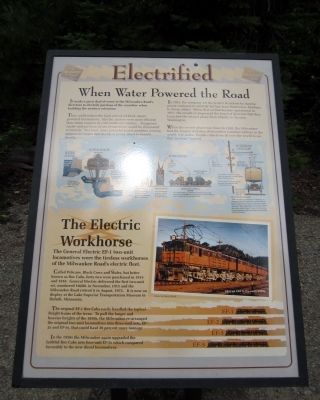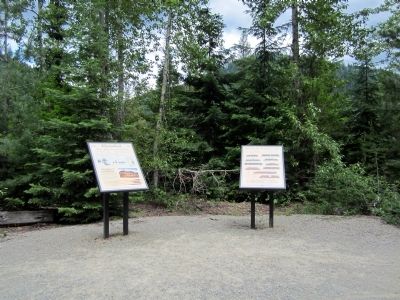Near Avery in Shoshone County, Idaho — The American West (Mountains)
Electrified
When Water Powered the Road
It made a great deal of sense to the Milwaukee Road’s directors to electrify portions of the mainline when building the western extension.
They could reduce the high cost of oil-fired, steam powered locomotives. Electric motors were more efficient than steam engines in cold northwest winters. Dangerous smoke and gas from steam locomotives would be eliminated in tunnels. Not least, some powerful board members owning interest in copper and electrical power stood to benefit greatly.
In 1912, the company set the project in motion by signing power contracts to electrify the line from Harlowton, Montana to Avery, Idaho. When that section became operational in 1917, the results so impressed the board of directors that they launched the second phase from Othello to Tacoma, Washington.
When the second phase was done in 1920, the Milwaukee had the longest stretches of electrified mainline railway in the world, 647 miles. People came from all over the world to see this “modern” marvel.
(sidebar)
The Electric Workhorse
The General Electric EF-1 two-unit locomotives were the tireless workhorses of the Milwaukee Road's electric fleet.
Called Pelicans, Black Cows and Mules, but better known as Box Cabs, forty-two were purchased in 1915 and 1916. General Electric delivered the first two-unit set, numbered 10200, in November, 1915 and the Milwaukee Road retired it in August, 1973. It is now on display at the Lake Superior Transportation Museum in Duluth, Minnesota.
The original EF-1 Box Cabs easily handled the typical freight of trains of the teens. To pull longer and heavier freights of the 193os, the Milwaukee re-arranged the original two-unit locomotives into three-unit sets, EF-2s and EF-3s, that could haul 30 percent more tonnage.
In the 1950s the Milwaukee again upgraded the faithful Box Cabs into four-unit EF-5s which compared favorably to the new diesel locomotives.
Topics. This historical marker is listed in this topic list: Railroads & Streetcars. A significant historical month for this entry is November 1915.
Location. 47° 20.492′ N, 115° 37.255′ W. Marker is near Avery, Idaho, in Shoshone County. Marker can be reached from Loop Creek Road (Federal Road 326) 4 miles west of Cliff Creek Road (Federal Road 506). Located along the Route of the Hiawatha Trail. Touch for map. Marker is in this post office area: Avery ID 83802, United States of America. Touch for directions.
Other nearby markers. At least 8 other markers are within walking distance of this marker. Milwaukee Road Muscle (a few steps from this marker); Johnson’s Big Cut (approx. 0.2 miles away); Signs, Wires & Whistles (approx. ¼ mile away); The Traveler (approx. ¼ mile away); The Mighty Quills (approx. 0.3 miles away); Olympian Luxury (approx. half a mile away); The Olympian Hiawatha (approx. half a mile away); The Big Blowup (approx. 0.6 miles away). Touch for a list and map of all markers in Avery.
More about this marker. On the lower right is a photo of an "EF-2 set E45 in the early 1970s" Photo by Bruce Black
Also see . . . Route of the Hiawatha Rail Trail. (Submitted on August 5, 2011, by Bernard Fisher of Richmond, Virginia.)
Credits. This page was last revised on June 16, 2016. It was originally submitted on August 5, 2011, by Bernard Fisher of Richmond, Virginia. This page has been viewed 666 times since then and 6 times this year. Photos: 1, 2. submitted on August 5, 2011, by Bernard Fisher of Richmond, Virginia.

